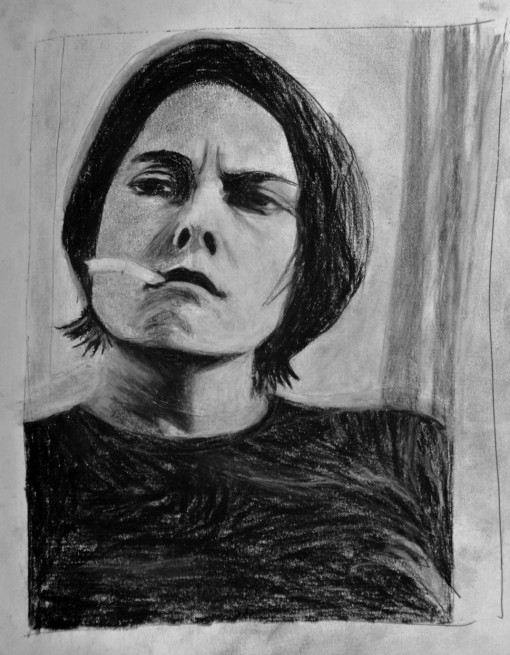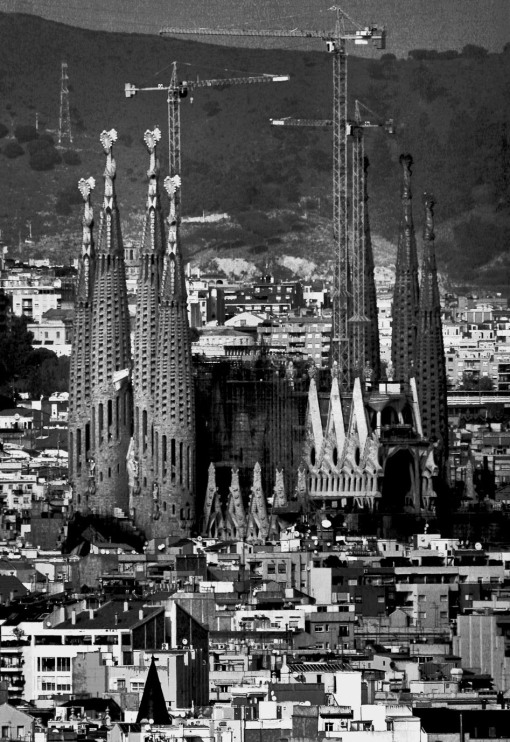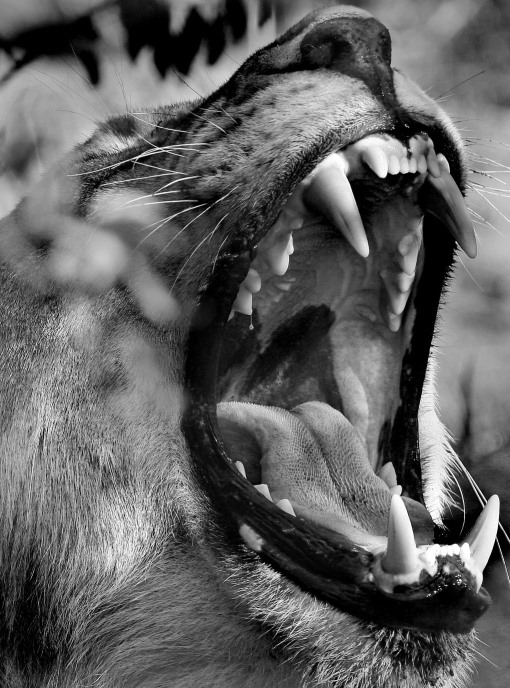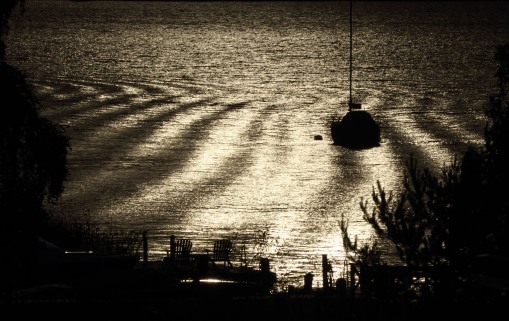A view of the Sermeq Avannarleq glacier in Western Greenland and its ice front, 29th May 2013. Take out the window during a flight from London to San Francisco. I did not know which glacier it was until late September when I found it on Google Earth at 70° 3’3.24″N, 50°19’1.22″W. Click on the photo for a full size view. According to the Byrd Polar Research Center, the Sermeq Avannarleq glacier lost 2 square miles from its ice front in 2007 and again in 2008. Increasingly rapid movement of this and other glaciers in south west Greenland is likely caused by surface melt waters percolating into the glacier, warming and lubricating the ice. You can find more scientific details in the AGU press release about Phillips et al., 2013.
Sermeq Avannarleq glacier, Torsukattak ice fjord, western Greenland late May 2013
27 09 2013Comments : Leave a Comment »
Tags: black, blue, Byrd Polar Research Center, Climate change, glacier, Google Earth, Greenland, ice, ice front, icebergs, out the window, photographic art, Sermeq Avannarleq, white
Categories : Landscape series, Science
Sarah Lucas – sketch from photo
1 07 2011Comments : Leave a Comment »
Tags: 2011, black, copy, drawing, graphic design, paper, pencil, photo, Sarah Lucas, self-portrait, sketch, white
Categories : Drawing
Study of Delacroix’s “An orphan girl in the graveyard” 1824
12 11 2010
Pencil on paper study of Eugene Delacroix's 1824 work entitled "An orphan girl in the graveyard" by Robert Corkery (2004). Sketching the orphan girl was an amazing way to experience Delacroix's sensationally powerful, expressive and visually magnificent portrait. Poised as if she had seen a ghost, the beautiful orphan girl in Delacroix's painting is probably visiting her dead parents in the graveyard, and she appears to be utterly conscious of an inescapable destiny. Delacroix's mastery of immediacy was probably a massive influence on the impressionists. One must view the colour version to feel the full impact of this work. After all he is celebrated as a colourist of inestimable influence. Today we might call him a drama-queen under some circumstances, but back in his day many critics perceived his work so dramatic as to be offensive. Delacroix was greatly influenced by Rubens amongst notable others. Delacroix lived 1798-1863.
My original sketchbook containing this pencil drawing was last seen in London July 2009. Fortunately I made a copy beforehand.
Comments : Leave a Comment »
Tags: 1798-1863, 1824, 2004, An orphan girl in the graveyard, black, canvas, colorist, colourist, consciousness, dramatic, emotion, emotional, Eugene Delacroix, expression, face, female, oil, painting, paper, pencil, people, personal expression, Robert Corkery, Romanticism, sketch, study, white
Categories : Drawing
Hötorget Market Stockholm
24 10 2010Comments : 1 Comment »
Tags: 2010, black, blonde, face, female, hands, Hötorget, head, human, long hair, people, photographic art, Scandinavia, scarf, Stockholm, white
Categories : People series
Emergence of Order II
19 09 2010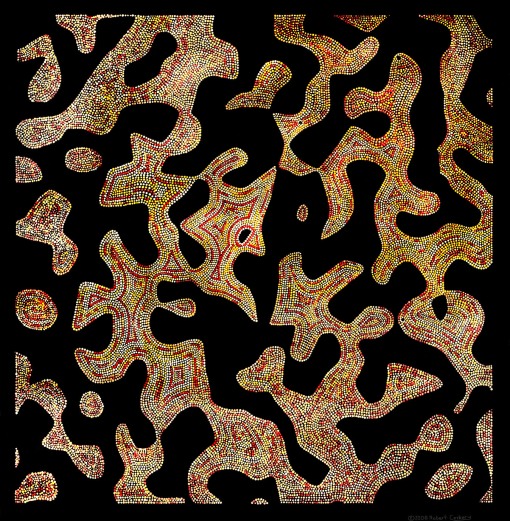
"Emergence of Order II". Photographic reproduction of original painting. Copyright 2006 Robert Corkery. 80 cm x 80 cm. Acrylic on linen. Red, yellow and white paint applied with a stick in the manner of an Australian aboriginal dot painting. The inspiration for the original work came from the complicated curved and interconnected tunnel structure and surfaces defining the inside of termite mounds. Mathematically these structures can be described in the same geometric language used to describe the huge network of inner membranes in the organelles of living cells, soap bubbles, punctured surfaces of complex black holes and therefore shape of spacetime itself including its strings. The language of differential geometry and topology is used to formally describe these surfaces and their inherent curvature. When Einstein read that Riemann introduced a concept that distance at any point in space changes depending on the distribution of matter in it, led him to a search for a geometric theory of gravity beginning around 1912 and three years later to celebrated general theory of relativity. The way that matter moves is determined by the curvature of the space. So the existence of forces in the universe is equivalent to the existence of curvature. The particular pattern in this painting was generated in a computer simulation using a 3D random Gaussian field of waves and then taking a cross section through it. The computer generated pattern was printed out onto gridded paper, and then I hand drew the pattern from the paper onto canvas. Dots of pure red, yellow and white were then applied to the canvas, painstakingly over several months. The patterns that emerged were not planned and surprised me as they became ordered, particularly as the painting proceded. This emergence of order is reminescent of the emergence of order in the evolution of the termite mound structure over geological time and over the lifetime of an individual nest. It mimics the order emerging in Nature due to evolutionary processes. This painting is the second dot painting in a series made on this topic. The first was destroyed in a deliberately lit apartment fire in New York City a few years ago. But a photograph remains!. The same type of pattern was used in the "oil spill" and "random Gaussian field" digitally created pieces posted earlier on this website.
Comments : 2 Comments »
Tags: 2007, acrylic, Australia, black, canvas, computer simulation, cross-section, dot painting, graphic design, linen, mathematics, pointillism, pointillist, random bicontinuous surface, red, reproduction, Riemann space, spacetime, Stockholm, termite nest, white, yellow
Categories : painting and fusion works, Science
Inside the lions yawn II
11 09 2010Comments : Leave a Comment »
Tags: 2008, black, canines, fangs, fur, incisors, jaw, Kruger, lion, male, Motswari, mouth, photographic art, safari, South Africa, teeth, tounge, whiskers, white, yawn
Categories : Animals, Wild series
2D-periodic-sculpture
24 08 2010Comments : Leave a Comment »
Tags: 2010, 2D, black, blue, computed, ordered, periodic, photographic art, Sculpture, surface, white
Categories : Uncategorized
Cart haulers Shanghai 2009
15 08 2010Comments : Leave a Comment »
Tags: 2009, black, cart, carting, China, hauling, photographic art, Shanghai, streets, white, wood
Categories : Cityscape series, People series
Ripple waves, dock and sailboat – Mefjärd island Stockholm archipelago
14 08 2010Comments : Leave a Comment »
Tags: 2010, ancored, Archipelago, black, buoy, dock, Mefjärd, ripples, sailboat, sepia, silhouette, somnar, Stockholm, summer, Sweden, waves, white
Categories : water scenes

